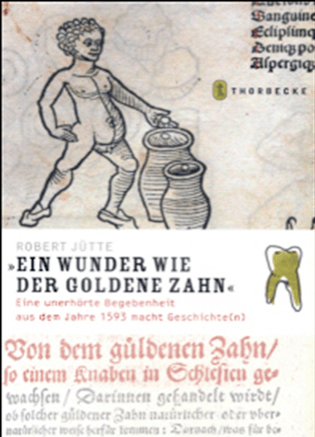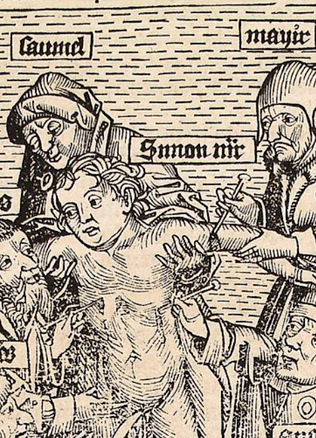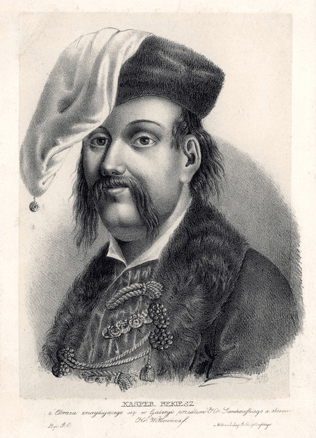Jagiełło’s Journey to Poland and Legend of the Stealing of the Holy Cross Relic
There is a story about the journey of Lithuanian Grand Duke Jagiełło, who was still a pagan, to Poland on the eve of the formal decision for a union between Lithuania and Poland in the Third Redaction (Bychowiec Chronicle) of the Lithuanian Chronicles. The foundation of the plot was refuting the claims of Polish chroniclers that Lithuania was joined to Poland as part of creating the union. According to Lithuanian chroniclers, it was in fact a humbled Poland that offered Jagiełło the opportunity to become its king. Another essential issue for Lithuanian-Polish relations was the baptism of Lithuania. According to Polish chroniclers, Poland was the baptiser of Lithuania, while Lithuanian chroniclers say that there was a tie with Western Christianity earlier, while the first to be Christianity to Lithuania were Lithuanian nobles.
The legend of honourable pagans
Both of these aspects are accentuated in the legend concerning the stealing of the Holy Cross relics. We can find in the Lithuanian Chronicles that: “As Jagiełło together with his army were marching through the Holy Cross, some of the soldiers rode up the hill to the Monastery of the Holy Cross. Among these soldiers was one from the Dowojno family. He took the relic of the Holy Cross tree, which was covered in silver, took that tree not because of its sacred nature, but because of the silver, and paying no honour to the tree, and wrapped it into a cloth.” In addition, Dowojno also took a girl “from the prominent Habdanka family, with whom he acted very honourably” hostage. Jagiełło together with his soldiers returned home victoriously and were met by Vilnans.
However the celebration was overshadowed by a strange death – pagans would fall dead upon touching the Holy Cross relic.
The concerned Dowojno asked about this from his Christian hostage. She said that an angel had shown her in a dream that it was in this way God was punishing pagans for acting dishonourably with the relic.
After Jagiełło was informed, he ordered the Holy Cross relic to be returned to the monastery, and together with it the girl that had been captured, and this is what Dowojno did. However, the girl offered the Lithuanian to go to her father and became her husband. “And thus, a cross was added to the Habdank coat-of-arms. And this is why the coat-of-arms began to be called Dubnia.”
The Annals of Jan Długosz: a Lithuanian stole it, but a Pole returned it
The Benedictine monastery of the Holy Cross on Łysa Góra (Bald Mountain) is one of the oldest spiritual centres in Poland and was especially revered by the Jagiellon dynasty. Thus, on the eve of the Battle of Grunwald, Jagiełło made his pilgrimage on foot to the monastery. It was also the special mausoleum of the Polish noble family Oleśnicki, which possessed the
Dębno coat-of-arms. The Dębno coat-of-arms has a cross with a double V, while the Habdank coat-of-arms had a double V.
Do You Know?
The Benedictine monastery of the Holy Cross on Łysa Góra (Bald Mountain) is one of the oldest spiritual centres in Poland. There are three versions of a legend that are known about the stealing and returning of the Holy Cross relic that is kept there: one in the Lithuanian Chronicles, one in the annals of Długosz, and one in the Narratio. The creators of a Lithuanian legend strove to show the ancient links of the Lithuanian nobles with Western Christianity as well as that they were equal to the Polish nobles up until the union with Poland.
What sources did the story come from? We see a similar story in the Annals of Jan Długosz. In 1370 after learning of the death of Polish ruler Casimir, Lithuanian dukes Algirdas and Kęstutis “invaded through the land of Lublin, and laid waste to the area of Sandomierz. […] along with other plunder, they took away the tree of the Living Cross taken from Bald Mountain. And the cart travelling along the Polish border, which took the Cross unexpectedly stopped and no one could move it [from its place]. And a Lithuanian pagan priest exclaimed: no one will be able to move the cart, unless the Cross wants to be returned to its place. Right away it was returned to Bald Mountain by a hostage, a Polish noble called Karabola, who received his freedom by this.”
The Tatar version of the kidnapped girl
Thus, in the Lithuanian Chronicle “one […] prominent Pole called Karabola” rather easily becomes “one” Lithuanian “from the Dowojno family.” However, the legend of the girl and the coat-of-arms is missing. We meet both of these elements in Narratio fvndationis monasterii Montis Calui Fratru[m] ordinis sancti Benedicti : necno[n] quomodo Lignu[m] viuifice crucis in montem illum est intronisatum (it was published in 1536 and 1538 in Cracow; it may have existed already earlier as a manuscript). The work tells a story about a Tatar attack (dated to 1254, though it should be 1260), during which the Tatars not only took away the relic of the Holy Cross they stole, but one of the Tatar rittmeister also took a virgin girl called Atleidė, who was the inheritor of Dębno Castle, as his wife by force. She convinced her kidnapper to return the relic. The Tatar rittmeister made preparations and went to Poland together with the virgin girl.
The king of Poland appointed him as voivode for his good deeds, providing him with a knightly coat-of-arms: a cross with two Vs, which in Latin stands for virgo violata, while in Polish it means kidnapped virgin.
In other words, it is known as the Dębno coat-of-arms in Polish heraldry. What is memorable is that the Tatar khan also took part in these events. On his order, the relics were tested with fire and water: miraculously it did not experience any effects from the fire and, despite the heavy silver covering, did not sink. The Tatar khan acts in a similar manner as Grand Duke Jagiełło in the Lithuanian Chronicle, though not in such a civilised manner.
The Transformation of the myth of the Holy Cross
There are different opinions as to the age of both Polish versions. Jan Długosz was a great supporter of Cardinal Zbigniew Oleśnicki, and it is thought that with the help of the Lithuanian version he attempted to push out the Tatar version that compromised the Dębno family (that the cardinal belonged to) in the eyes of the Polish boiar society. The members of the Dębno family (and John, the cardinal’s father) had troubles due to their Tatar past in the 15th century, and even had to ask their ruler for a special privilege. This allows one to state that the Tatar version is older. Another thing is the question of the link between the Narratio and the Bychowiec Chronicle. The work was published already after the writing of the Bychowiec Chronicle. To employ the use of the latter (i.e. that Jagiełło would have been turned into a Tatar khan) seems to be unrealistic. This would be sacriligious in a work like the Narratio. Thus, the only possible thing is vice-versa. Jagiełło is mentioned only at the end of the Narratio: he supposedly had already left to visit this famous place as the future king of Poland, but he was still a pagan.
Thus the sources for the Lithuanian Chronicles are the following: Długosz’s annals (or the chronicle compiled by Maciej Miechowita based on the annals), and the Narratio or a work similar to it, or unrecorded local legends, which could have been spread by pilgrims in Lithuania.
Do You Know?
The creators of a Lithuanian legend strove to show the ancient links of the Lithuanian boiars with Western Christianity as well as that they were equal to the Polish boiars up until the union with Poland. However why was the name of Dowojno chosen for the hero? Dowojno was a well-known Lithuanian boiar family. Andrius Dowojnoitis (Andrzej Dowojno, 1527) was the starosta of Eišiškės and trusted friend of the person who commissioned the Lithuanian Chronicles, Vilnius Voivode Albertas Goštautas. In this way the origins of this family was given meaning in the historical tradition of Lithuanians.
Literature: Lietuvos metraštis. Bychovco kronika, vertė, įvadą ir paaiškinimus parašė R. Jasas, Vilnius, 1971, p. 89–91.
Kęstutis Gudmantas



